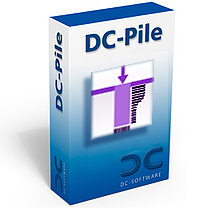DC-Software products
Article

DC-Pile
The DC-Pile program can be used to design individual piles such as bored piles, driven/displacement piles, micro/grouted piles and ductile piles. The piles can be calculated as compression piles and tension piles. For the soil layers, the characteristic parameters such as the skin friction, the peak pressure and the stiffness or the subgrade modulus (for the foundation) have to be defined. For the peak pressure and the skin friction, the characteristic values specified by DIN 1054, ÖNORM B 1997 and the Recommendations of the German Pile Work Group EA-Pfähle are stored in the program.
Videos
Description
- Selectable pile types: bored piles, displacement piles (driven piles), micro piles (grouted piles) and ductile piles
- Calculation as a compression or as a tension pile
- Vertical or with an inclination
- Optional toe expansion for bored piles
- Variable horizontal soil stratification with specification of the characteristic parameters: skin friction, peak pressure and stiffness modulus for the foundation
- The characteristic values for the skin friction and the peak pressure specified by DIN 1054, ÖNORM B 1997 and the EA Recommendations are available for cohesive and non-cohesive soils and rock
- Horizontal ground surface
- For the accurate internal modelling of the structural system (e. g. soil stratification), it is possible to import DXF graphics as a background
- Several load cases with vertical and horizontal loads or concentrated loads acting in the pile direction, concentrated moments and lateral pressure as a line load over the pile height, large-area structural loads on the ground surface
- Calculation and representation of the foundation, the internal forces and the deformation of the pile
- Calculation of the existing safety and settlement at a given load or the permissible load at a given settlement taken from the resistance-settlement curve
- Calculation of the safety at an existing length or the required pile length
- Calculation and representation of the resistance-settlement/heave curve for bored and displacement piles according to the EA Recommendations and for micro piles according to the approach by Ischebeck
- Verification of the external stability via the skin friction and the peak pressure for vertical loads and via the elastic support with adaptation to the passive earth pressure for horizontal loads
- Punching shear analysis with load propagation into weak soil layers
- Verification of the activated earth mass for tension piles
- Verification of the internal load-bearing capacity as per EC2 and EC3
- Optional calculation of piles in slopes, e. g. for noise protection walls, with DC-Pile/Noise Barrier in accordance with the approach by Vogt
- Detailed output of the individual load cases as text and graphics
- Output options: printer, PDF
- Interfaces: RTF export to MS Word, graphic export in JPG format, DXF export
Foundation engineering standards
- EN 1997-1
- DIN EN 1997-1
- ÖNORM B 1997-1-1
- NF EN 1997-1
- BS EN 1997-1
- UNI EN 1997-1 with NTC 2018
- UNE EN 1997-1
- DIN 1054
- DIN EN 1536
- BS 8004
- SIA 267
- ÖNORM B 4440
- Recommendation of the Pile Work Group EA-Pfähle
Reinforced concrete standards
- EN 1992
- DIN EN 1992
- ÖNORM B 1992
- NF EN 1992
- BS EN 1992
- UNI EN 1992
- DIN 1045
- SIA 262
- ÖNORM B 4700
- BS 8110
Steel standards
- EN 1993
- DIN EN 1993
- ÖNORM B 1993
- NF EN 1993
- BS EN 1993
- UNI EN 1993
- SIA 263
- BS 5950






